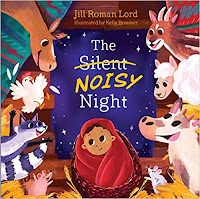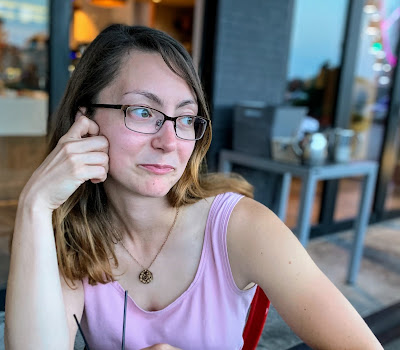CHILDREN'S AUTHOR INTERVIEW
As a debut children's author, Amanda Brindley invites families to slow their pace and tune in to the simple wonders in nature all around us. And she helps families with highly sensitive kids feel seen through her picture book, Doodle's Mountain.
"A delightful read-aloud for small children," writes Amanda's publisher, Bandersnatch Books. "It engages them in a playful response to overwhelming environments, evokes wonder, and encourages readers to be in awe of beauty."
Let's jump into our interview with Amanda to learn more about her and her first book.
1) Which children's book has most impacted you? Why?
I love Miss Rumphius by Barbara Cooney. It’s set in New England, where I grew up, but also includes her travels to foreign places and her adventures. The story expresses a high value for beauty explicitly but offers gratitude and inspiration.
Every time I read the middle section of that picture book and watch Miss Rumphius aching to plant more lupines from her bed, and then see her venture out when she’s feeling well in the spring to find that the lupines have spread on the wind, I feel the truth of more at work in the world than me or than what I can fully understand. It inspires me to look for the Holy Spirit at work in my own life.
Miss Rumphius meets her discovery with gratitude and then with action—she orders an enormous bushel of seed and goes walking for miles, spreading the seeds until the whole town is covered in lupines. This story of beauty unfolds gently, with soft, immersive illustrations, and unexpected inspiration. Anytime I read it, I’m encouraged to notice the world more closely and to wonder what I might do to make it more beautiful.
2) What do you love about writing for kids?
I love kids and writing is one way to reach them. I’m a nanny and I’ve always gotten along well with little children and babies. In our modern world, and in the mundane day-to-day, I see how often children are considered an inconvenience because they dawdle and whine and stop to look at every blade of grass and don’t understand the speed at which we must run to the next thing. They waste food and make everything dirty and can’t see why that’s a problem. They want desperately to help with activities that are far beyond their abilities. We grown-ups tend to tire of the endless energy and curiosity and words that children offer.
I tend to see a child as a whole little world unto herself, a chance to reignite my own awareness of what God has made and called good. I’ve only noticed birds and grass and dirt and leaves and trains and owls as things of wonder and beauty because of children I’ve known. They see the world, literally and figuratively, from a different vantage point than adults. They’re not worried about money or efficiency and, while we all have to grow up and be responsible within all the complexities of life, children aren’t there yet, and they have something beautiful to tell us: the world is bigger than our grown-up concerns.
We might relax more if we pay attention to what is working far outside of our control and let ourselves stare at clouds or bugs, play in the dirt, or bake bread for the love of it. The world is a place to work and play, and children will teach us to play if we let them. I love being with children and helping them learn about their world and writing for them is a way to encourage and reach children and caregivers I’ve never met.
3) What is it about writing picture books that most sparks your interest?Picture books offer a visual and verbal story tied together which is unique in the world of reading. They are meant to be read aloud and they’re often poetic in their form which makes them easy to memorize.
As a nanny, various picture books have shaped the language we use to communicate. Sandra Boynton’s silly board books, memorized by accident, can lighten a difficult moment for a toddler in an instant. I love that picture books make the unknown world recognizable and already familiar for children.
Picture books spark playfulness and joy that might otherwise get lost. They’re a wonderful point of connection between kids and caregivers, an opportunity to sit side-by-side and pay attention to the same images and words in the quiet. The best picture books become part of a shared family vocabulary, like dear friends waiting to be revisited.
4) What sparked your idea for your picture book, Doodle's Mountain? Eight years ago, I was eating goldfish crackers with the almost-two-year-old boy I nannied. We were talking about the birds and squirrels in the backyard, looking out the window, and heard a truck pass loudly on the highway. He said, “Shhh…” to the truck, finger on his lips. The moment I laid him down for nap I scribbled out the first draft of this story on a sheet of notebook paper.
5) What do you hope readers take away from Doodle's Mountain?
Doodle’s Mountain is a story about a highly sensitive child’s experience of family vacation. I hope that resonates with families who have highly sensitive children and gives them a touchpoint for connecting in difficult moments.
The deeper message of the story is for all of us, however our personalities affect our day-to-day lives. I hope the story sparks wonder in readers, encourages quiet, helps people to see beauty in their own surroundings, lives, children, work, and adventures.
The mountain is saying, “Shhh…” to all of us and I hope that means something personal to each person who reads the book. W.B. Yeats said, “The world is full of magic things, patiently waiting for our senses to grow sharper.” I hope this book will be one sharpening tool for those who read it.
6) What is a way families can incorporate mindfulness for highly sensitive children they may encounter at home, school, church, or in their neighborhood?
Each child differs in how much noise and activity they need and can handle. Each child differs in how he will tell you he’s getting overstimulated. One of the best things to give a child is the language to talk about emotions.
Toddlers have a capacity for this if they’re given the tools. Oftentimes disobedience, meltdowns, or acting out are rooted in being overwhelmed (in toddlers). This doesn’t mean they should be allowed to do whatever they want, but as a parent or primary caregiver, you can offer a child tools to express emotions without meltdowns. Help them identify emotion: “you’re feeling frustrated right now because…” or “you feel disappointed because you wanted this and it isn’t time now.” You can instruct them to say, “I feel disappointed,” instead of screaming or whatever other inappropriate behavior they’re engaged in.
Children don’t want to feel out of control in their bodies, which is exactly what happens when they become overstimulated. Obviously, this isn’t always the case, but for highly sensitive kids it can happen much more quickly.
Once you have an idea with your child of where that line is and what might be too much, you can prepare him for any scenario where you know it might overwhelm him and help develop strategies for staying calm. Those are going to vary for every kid, but might include a hug, a hand to hold, a toy to fidget with, closing his eyes for a couple of minutes, breathing deeply, or thinking about something positive. Often what kids are seeking in a meltdown is connection to a caregiver who is going to reintroduce stability and take control.
The world is loud, so giving the children in our families and communities the tools they need to engage it well is a much better strategy than protecting them from what might be difficult for them. We want to enable our children to reach their fullest capacity, helping them navigate and grow from challenges even at a young age!
Be sure to keep an eye out for more author interviews! Swing by on Augst 13th to meet the next author in this series.
Also, mark your calendar to catch a new interview series with Third-Culture Kids launching in August! I'll interview kids living in different cultures. It will be a fun series to dive into with your entire family!
AMANDA BRINDLEY grew up in Maine, where she started writing stories in the wee hours of the morning when she was six. As a child, she loved ice cream shops with cows to visit and old libraries full of books. She grew up to also love wildflowers, mountains, road trips, camping, gardening, and spending time with friends and their small children in New England and beyond. She’s a nanny to her cousins, two little girls who keep her laughing, busy, and looking out for owls and trains like only a two-year-old can. She lives in Ohio, but listening to the crashing waves and breathing in briny ocean air as the tide recedes is still her favorite thing in the world.
Amanda's book:























.png)





